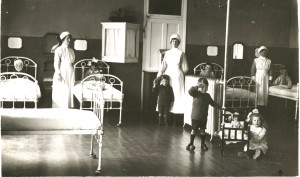Like people up and down the country soon after the outbreak of WWI the staff and patients of Stannington Sanatorium began to see its effect. Reports made by the matron over the war years give some indication of the kind of changes that were felt by the sanatorium.
August 1914
“During the month of August 29 cases were admitted and 29 discharged. We have now 110 cases under treatment. Last month we had 4 cases of chicken pox & 2 cases of scarlet fever.
On August 6th the sister was called up to join the territorial nursing force. I have not managed to get anyone to fill her place. Have I the authority to tell sister that her post will be kept for her? Tho’ the time she will be kept is uncertain.”

HOSP/STAN/11/1/41
January 1916
“We had on Thursday evening a visit from the policeman.
We have for some considerable time now had all our lights shaded & I have been very careful that no bright lights should be seen form here.
I think Dr Allison will agree with me when I say it has been most difficult to find our way about in the sanatorium the lights have been so subdued.
However, the policeman informed me that having the lights shaded was not sufficient now & after Monday the place would have to be in absolute darkness, not even a candle light seen, & that the windows would have to be curtained, so that I have had to go to some little expense this week to get material for curtains in.”
.
.

Matron’s comments on the zeppelins
April 1916
“Nothing of any consequence has happened during the month except, I might say, on Sunday night last we had a bit of a scare with the zeppelins. They were certainly very near us. We could hear the engines overhead quite distinctly.
The staff were all up, & several of the soldiers from the Farm Colony very kindly came and offered their help in the case of any bombs being dropped near us.
A good many of the children heard them, but they were as good as gold & behaved splendidly. There was no panic whatever, but everyone was in readiness to do their best should the worst have occurred.
I had several of the children visiting here next day enquiring if we were alright.”
See an earlier post by the World War One Project for more about airships in Northumberland.
Images relating to the zeppelin raids over Northumberland can also be seen on our Flickr stream https://www.flickr.com/photos/99322319@N07/sets/72157642003621114/
